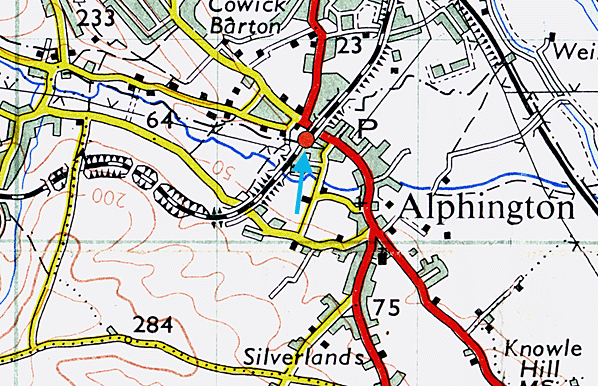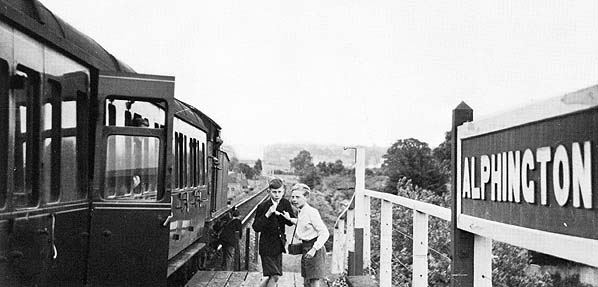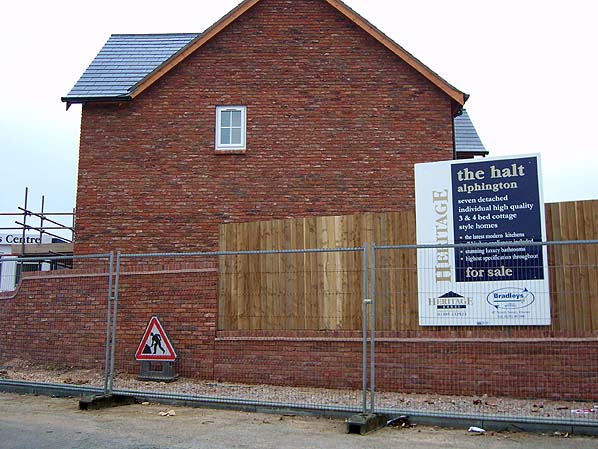|
Notes: Alphington Halt had a 100ft long wooden platform with a flat roofed corrugated shelter located on the eastern side of the track, it was reached by a track from a footpath. Passengers without tickets joining the train at the halt were booked by the guard.
On some summer Saturdays in the 1950's one train from Newton Abbott terminated at Alphington Halt and passengers continued to Exeter by bus as St. David's was very busy with holiday trains during the middle of the day.
BRIEF HISTORY OF THE TEIGN VALLEY RAILWAY
The Teign Valley Line was originally authorised in 1863 as a broad gauge line, although it did not open until 1882. The line ran as standard gauge from Heathfield to Ashton, although it was isolated from the GWR system as the Moretonhampstead line at Heathfield was still broad gauge.
Some forty years later, the Exeter, Teign Valley and Chagford railway was formed to build a line from Exeter to join up with the existing line connecting at Christow station. This opened on 1st July 1903 some 9 years after the first sod had been cut by Lady Northcote, wife of the Member of Parliament for Exeter on 7th November 1894. The 1st official train left St Thomas station (Exeter) at 3.40pm and arrived at Ide at 4pm calling at all the stations on the line where each parish council laid on festivities and the usual address by councilors.
The line which extends from Heathfield on the Newton Abbot to Moretonhampstead line in the south to Exeter on the main London to Cornwall line covers a total of 17 miles. It consists of approximately 25 bridges, 30 culverts and 2 tunnels, one each side of Longdown station. These tunnels were built to hide the offensive sight of the trains from Edward Byrom of Culver House which stands in parkland above the railway.
The largest customer for goods traffic on the line was the Teign Valley Granite Company which had quarries at Trusham and Crockham. Not only was the line used for local connections but it also provided an alternative route to Cornwall, bypassing the troublesome route from Exeter to Newton Abbot which regularly (and still does) suffered from the elements from the sea around Dawlish
Prior to the opening of the through line in 1903, passenger services on the original line consisted of 5 trains daily in each direction on weekdays only, with no trains at all on Sundays. When the line opened from Exeter the passenger service was integrated with that of the Teign Valley Railway. The Exeter Railway and the Teign Valley Railway were both absorbed into the Great Western Railway in 1923.
Passenger numbers reached their peak in the 1930’s with seven daily services provided each way between Exeter and Heathfield. During World War 2 this was reduced to four trains in each direction, still with no trains on a Sunday. This was increased to five daily trains after the war.
By then it was becoming obvious that the branch was going into decline as more people took to the motor car as their main form of transport, a trend that was happening nationally. As a result BR decided to withdraw passenger services a full 5 years before the start of the ‘Beeching Axe’, even though Ashton station had only been repainted the year before closure.
In 1957 The British Transport Commission proposed to withdraw the passenger train service between Exeter (St David’s) and Heathfield and to close down Longdown station. It was followed in early 1958 by a further notice saying that as from 3rd March 1958 that the passenger train service between Exeter (St David’s) and Heathfield stations would be permanently withdrawn and Longdown, Alphington, Ide, Dunsford and Chudleigh Knighton would be closed for passengers and goods. The parcel service would still continue for the delivery and collection of parcels at Chudleigh, Trusham, Ashton and Christow stations. The line was granted a short reprieve by a protest by St Thomas Rural District Council (Exeter) because of the inadequate bus service, this reprieve was short lived as on 9th June 1958 the passenger service was finally withdrawn and the section of line from Exeter to Christow closed completely.
The track on this section was lifted in February 1962 except for the short length from Exeter to Alphington Road sidings (Marsh Barton Industrial estate). This part of the line still survives today, serving a scrap metal company and this is still used regularly (2010), beyond here towards Heathfield the line has been severed by a supermarket.
BR's reasoning behind the closure was the line was only used for an average of 193 daily journeys and closure would give them a saving of £15,000 per annum with a further saving of £30,000 that would be required for general up-keep of the line.
March 1961 saw flooding which damaged the line between Christow and Ashton resulting in the closure of the line east of Trusham. BR officially closed the section of line between Heathfield and Crockham sidings (just south of Trusham) on 1st July 1968.
Further reading: The Heathfield to Exeter (Teign Valley) Railway by Lawrence Pomroy - Forest Publishing 1995 ISBN 1 873029 04 7
Teign Valley Line by Peter Kay - Wild Swan 1996 ISBN 1 874103283
Branch Line to Moretonhampstead (including Heathfield - Exeter) by Vic Mitchell & Keith Smith
Middleton Press 1998 ISBN 1 901706 273
Walking West Country Railways by Christopher Somerville - David & Charles 1979
ISBN 0 715381421
Devon's Railways by Helen Harris - Bossinney Books 2001 ISBN 899383 40 9
Branch Lines of Devon by Colin Maggs
- Sutton Publishing 1995 ISBN 1 84015 022x
To see other Stations on the Teign Valley Railway click on the station name: Heathfield, Chudleigh Knighton Halt, Chudleigh, Trusham, Ashton, Christow, Dunsford Halt, Longdown & Ide Halt
|

old3.jpg)



 Home Page
Home Page 



